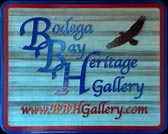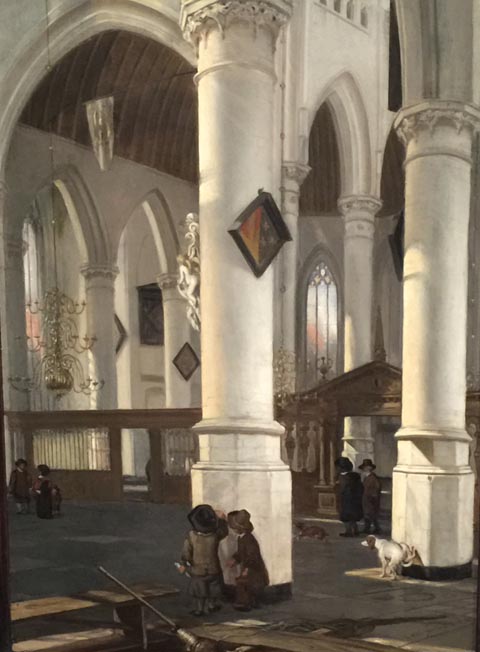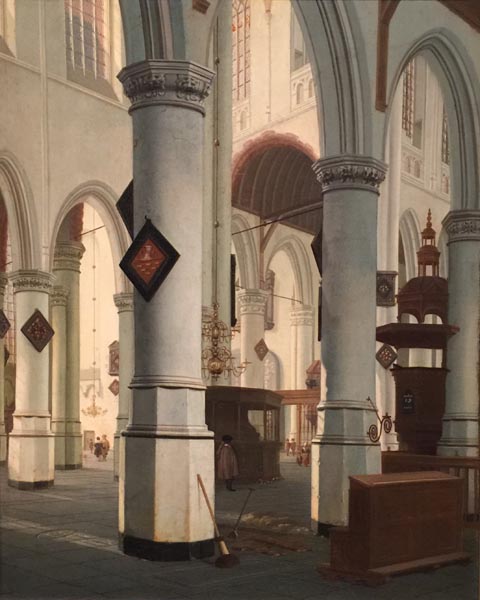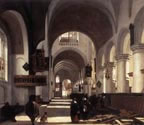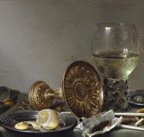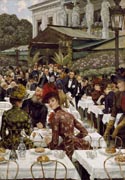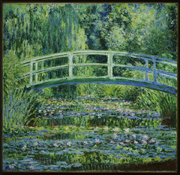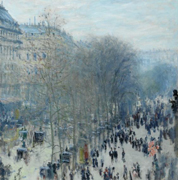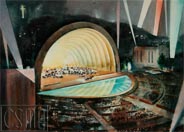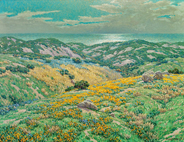With Australia's wildfires
in mind, from our collection
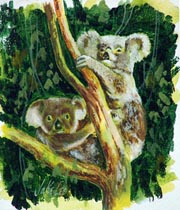
Koalas,
7 x 5-3/4, by well known
San Francisco artist
Jake Lee, 1915-1991 |
Bodega Bay Heritage Gallery Monthly
January 2020
an online fine art gallery
based in Bodega Bay and also Graton, California
celebrating Historic California painting |
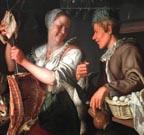
Dutch painting for an
Emerging Secular World,
Dutch Masterpieces at the Met
|
Serving clients by appointment In Northern California and beyond, in Bodega Bay, Graton, in your home, or online. Our prices are posted.
We do not do online transactions. Client contact is off-line, via phone, text, email or in person. Purchases are with credit card, Paypal, check, or cash.
California sales tax of 8.25% applies in California.
Email: Art@BodegaBayHeritageGallery.com
Voicemail and Text: 707-875-2911
|
Now at Linda Sorensen's artist studio
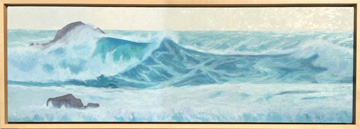
Linda Sorensen, Against the Wind
Oil on linen,
12 x 36, third in a series, Bodega Bay shorebreak |
| |
|
|
|
Dutch paintings
for an emerging secular world,
Dutch Masterpieces at the Met
by Daniel Rohlfing |
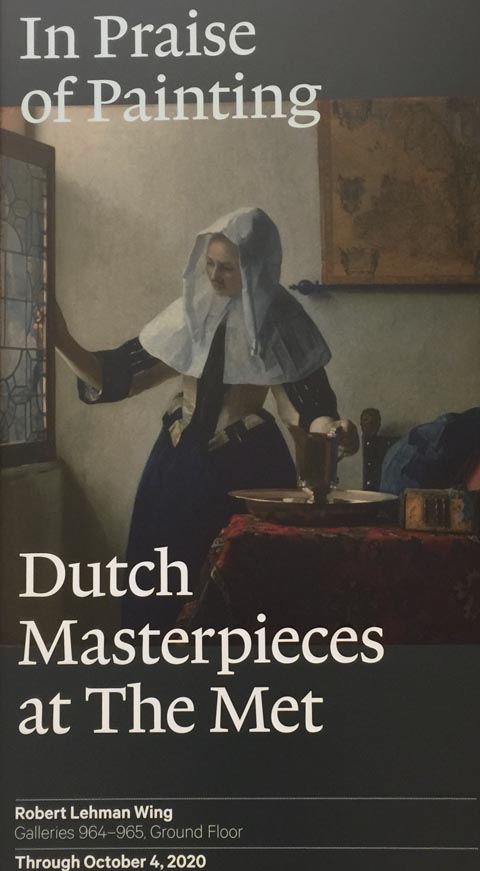 |
In the 17th century, the Dutch dominated world trade. From around the world, they imported new flavors, fashions, and ideas to an increasingly secularized Dutch culture.
|
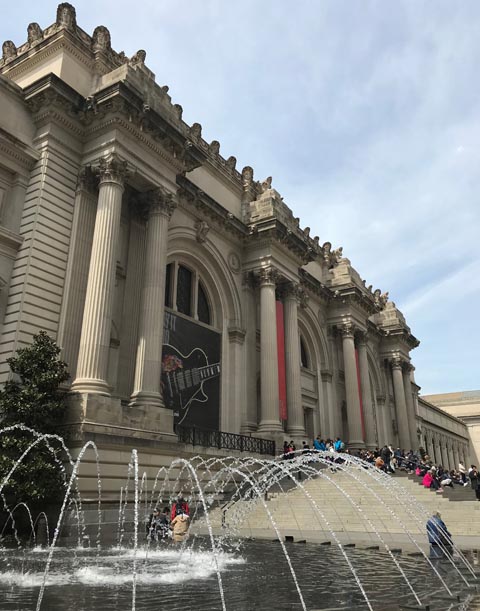
The 5th Avenue entrance of
New York City's Metropolitan Museum of Art |
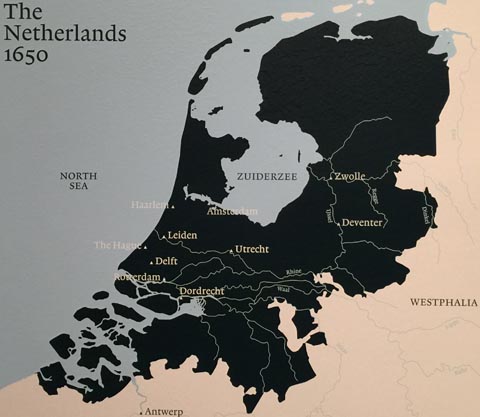
17th century Dutch painters sometimes painted outdoors in winter.
Their use of broad skies gave dimenion to the otherwise flat Netherlands landscape. |
17th century Dutch painters provided a much needed change in the art world.
Before the Dutch, Baroque painters
filled Europe's palace and churchly walls with Biblical scenes or scenes from classical mythology or history. Their portraits heaped praise on the high and mighty, never giving a nod to the working or merchant classes.
But in the 17th century, the Dutch painters changed things. They painted pictures celebrating the merchant and working classes. They did so with great color, exceptional composition, and marvelous exploration of the effects of outdoor light on indoor scenes.
Genre paintings told fresh secualar stories flavored with humor and naughtiness. Landscapes showed the flat Dutch countryside and coast with cloud filled expansive skies. Portraits of common folk showed off the latest styles, and sometimes featured facial expressions conveying humor or innuendo. Still lifes included items brought to Holland from all over the world, products of Dutch trade - often symbols of a more elaborate style of life.
The lines between these types of paintings (still life, landscape, genre) were not rigid. Each type often showed elements of the others.
|
| Genre paintings (from 1616 to 1670) |
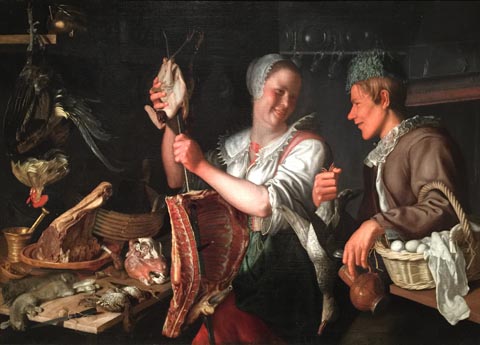
Peter WteWael, 1596-1660
Kitchen Scene, 1620's |

Hendrick Sorgh 1609-1670
A Kitchen, 1643 |
Kitchen scene by Peter WteWael is typical of Dutch genre paintings. Here, a delivery boy visits a housemaid busy in the kitchen. They enjoy each other's company as the housemaid skewers fresh meat. Her kitchen counter is filled with lavish food- stuffs. The scene shows a flirtatious encouter amid the bounty of good times.
A Kitchen by Hendrick Sorgh is a genre domestic scene with still life. The kitchen maids clean fish and peel vegitables surrounded by gleaming brass and earthenware. A close look shows a cat (far right) drawn by the scent of fish or perhaps the open bird cage barely visible between the two servants.
|

Pieter De Hooch, 1629-1684
The Visit, 1657 |
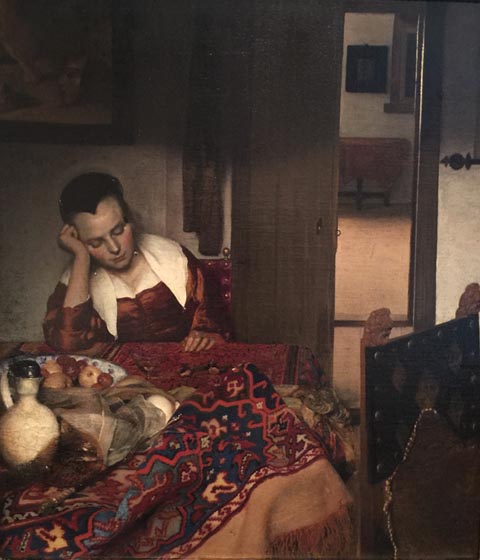
Johannes Vermeer, 1632-1675
A Maid Asleep, c 1656-57 |
The Visit by Pieter De Hooch is a generic scene of the seedier side of life. It takes place in a street-facing room in a narrow Dutch row house, the room that received the best outdoor light. A plate of oysters is on the table, served with aphrodisiac purposes in mind, with a canopied bed suggesting that this is a scene in a brothel rather than a respectable home.
As a painter, De Hooch began his career in Delft and is known for side lighted interior genre scenes. Critics believe De Hooch influenced Johannes Vermeer who was three years younger. In the late 1950's, Vermeer's paintings began to reflect the technical achievements of De Hooch. Of the two painters, De Hooch possessed greater range and was more prolific than Vermeer.
In A Maid Asleep, Johannes Vermeer investigates light, color and texture rather than focusing on the misbehavior of a maid falling asleep after having consumed some of the master's wine on the sly. The toppled glass at the left and rumpled table cloth indicate a rapidly departed figure. X-radiographs of this painting indicate that Vermeer chose to remove a male figure he had originally included standing in the doorway, choosing to focus on the sleeping maid.
|
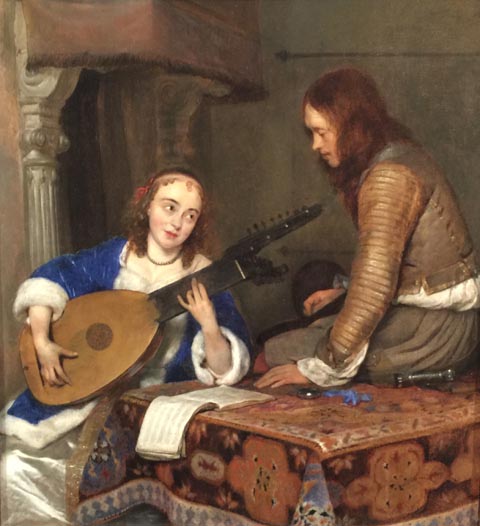
Gerard ter Borch The Younger, 1617-1681
A Woman Playing the Theorbo-Lute and a Cavalier, c 1658 |

Gabriel Metsu, 1629-1667
A Musical Party, 1659 |
Gerard ter Borch The Younger influenced fellow Dutch painters Gabriel Metsu, Gerrrit Dou, Peter De Hooch, and Johannes Vermeer. He is known for painting scenes of the inner sanctum of Dutch homes, showing figures and hinting at interesting and tasty bits of their inner lives. Gabriel Metsu painted across a wide spectrum of painting types, doing history paintings, still lifes, portraits and genre works. His genre paintings were often of young girls doing common things, like feeding pets or shopping for vegetables at a market.
In A Woman Playing the Theorbo-Lute and a Cavalier, Gerard ter Borch The Younger shows a young woman strumming while singing a duet with her lover. Secularization not only was present in Dutch painting, but also in how the Dutch approached music. Making music was a popular pastime, and songbooks were valued, often as lovers' gifts. To the typical 17th century Dutch viewer of this painting, the watch lying beside the suitor's left hand may symbolize temperance or perhaps the fleetingness of the affair.
In A Musical Party, Gabriel Metsu shows us a scene of indulgence and temptation. The wealthy dressed woman is seated in a richly appointed dress. She is turning to offer a songbook to the dandy standing behind her while nonchalantly holding the neck of her lute. Another beribboned gentleman has cast off his sword while picking up viol. A servant girl approaches at the doorway bringing refreshments.
|
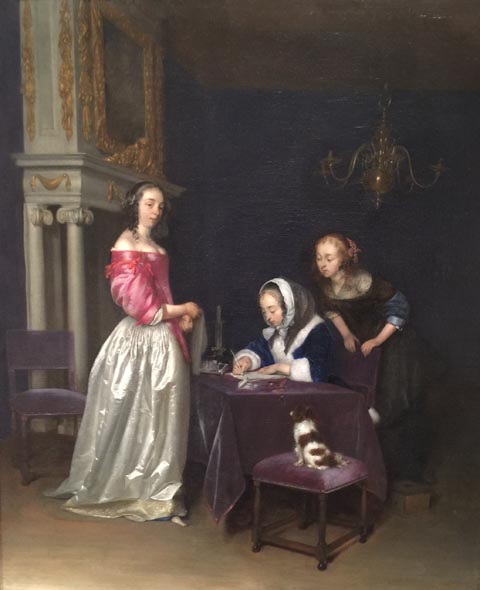
Gerard Ter Borch The Younger, 1617-1681
Curiosity, c 1660-62 |

Pieter De Hooch, 1629-1684
Interior with a Young Couple, c1662-65 |
Gerard Borch established a new framework for genre painting, showing figures in their own homes going about the activities of their inner lives. In Curiosity, he shows an older woman composing a letter to a suitor for the younger woman in red, presumably the older daughter, while the younger daughter's curiosity causes her to lean over the shoulder of the older woman as she writes. The attentive small dog rounds out the scene. Unlike most European women of the 17th century, Dutch women were schooled and skilled in reading and writing.
Pieter De Hooch was skilled at showing oudoor light falling into interior space in cascading rectangles created by the architecture. Into this fascinating setting, he captures a glimpse of the private lives of prosperous families. In Interior with a Young Couple, he captures a personal moment for this couple as a woman gazes into her mirror and the man plays with their dog.
|
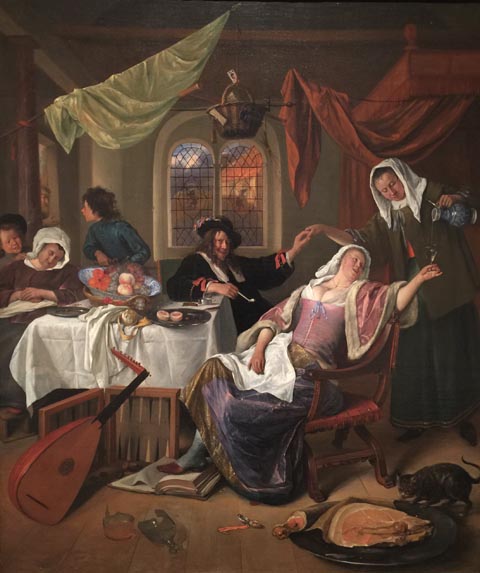
Jan Steen, 1626-1679
The Dissolute Household, c 1663-64 |

Pieter De Hooch, 1629-1684
Leisure Time in an Elegant Setting, c1663-65 |
"Jan Steen enjoyed making himself the butt of jokes." In The Dissolute Household, the gallery placard additionally reads, "He entwines his fingers with those of the maid while the maid is pouring a generous glass of wine for his wife."
|

Jan Steen, 1626-1679
Merry Company on a Terrace, c 1670 |
"A broken glass, a mischievous cat and romping young boys underscore the message that this is a household run amok. Suggestions of an ominous fate hang literally over the family's heads in the form of a basket containing a beggar's crutch, can, clappers, used to warn of leprosy or the plague, and the jack of spades, signifying misfortune."
Leisure Time in an Elegant Setting by Pieter De Hooch shows a more tranquil scene, at least at first glance. Here, a family in a luxuriously appointed room sit at a table with Chinese porcelain. Above the fireplace is a painting of nude lovers. But the family's comfort is interrupted slightly by a scene playing out on the right side of the painting. There, a young man is proceeding toward an open front door, perhaps to engage a beggar seeking alms.
The exhibition placard for Merry Company on a Terrace reads, "Another of Steen's self-deprecating depictions of his own unruly household, this painting centers on the inviting figure of his wife, who looks out at the viewer with an empty wineglass in her hand. Steen pictures himself, face flushed with drink, and a comic hat on his head." Today in the Netherlands, when a household in disorder or domestic chaos is described, people call it "a household by Jan Steen."
|
| Landscape paintings (from the early 1650's to 1670) |

Salomon Van Ruysdael, 1600-1670
Drawing the Eel, early 1650's |
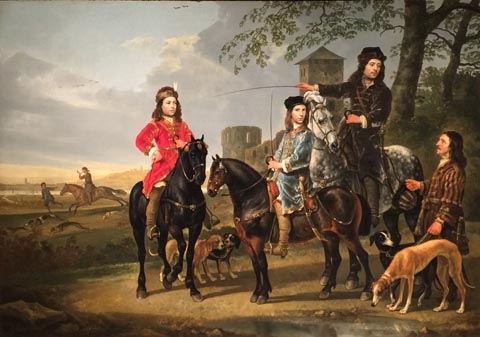
Aellbert Cuyp, 1620-1691
Equestrian Portrait of Cornelis and Michiel Pompe van Meerdervoort
with their Tutor and Coachman, 1652-53 |
Against a wintry sky and bare branches, a village road becomes the setting for a cruel pastime. Salomon Van Ruysdael's Drawing the Eel shows a rather gruesome scene. Youg people place a live eel strung on a line onto a road so that young riders on horseback can charge past, killing the eel. This contest provides the pretext for a festive gathering, allowing Ruysdael to combine his eye for local color with an evocation of glassy winter light and its reflection in the frozen skating pond below.
|
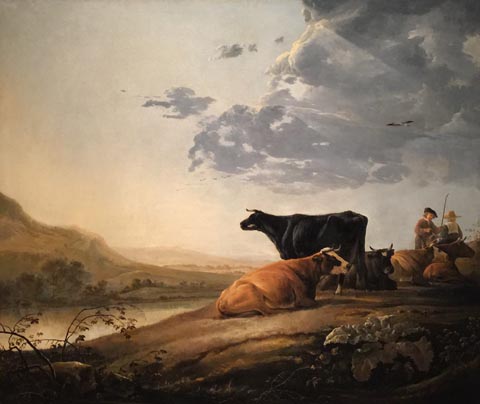
Aelbert Cuyp, 1620-1691
Young Herdsmen with Cows, 1655-60 |
Equestrian Portrait of Cornelis and Michiel Pompe van Meerdervoort with their Tutor and Coachman shows two adolescent sons of an eminent family. It was most likely commissioned by their widowed mother. The placard reads, "Instead of depicting an actual country estate, Cuyp placed a ruined castle in the background, evoking the sitters’ ancient lineage. Sitting astride horses, accompanied by retainers and hounds, the two youths pose as propertied huntsmen, ready at any moment to depart for the conquest of their prey. Cuyp’s skill as a landscape painter is in tension with the relative awkwardness of the figures."
Aelbert Cuyp's Young Herdsmen with Cows shows sun-streaked clouds racing across the sky, dominating this placid landscape, a classic example of the luminous style that made Cuyp a beloved artist among eighteenth- and nineteenth-century collectors. Based on studies made in nature, the painting is nonetheless a studio confection. Resting livestock and agrarian laborers appear as timeless parts of the landscape in a reassuring vision for the landowning collectors able to display such a monumental scene.
|
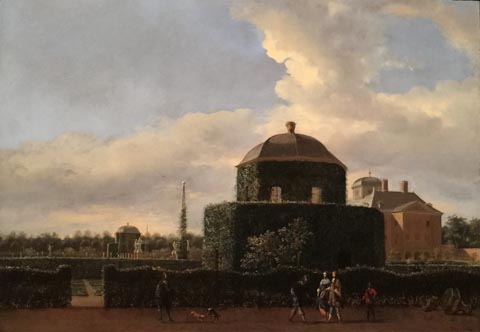
Jan Van Der Heyden, 1637-1712
Huis ten Bosch at The Hague and its Formal Garden
View from the South, c 1668-70 |
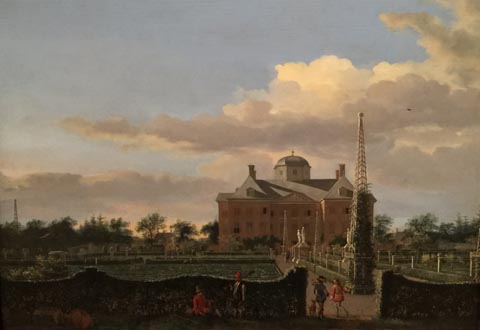
Jan Van Der Heyden, 1637-1712
Huis ten Bosch at The Hague and its Formal Garden
View from the East, c 1668-70 |
Jan Van Der Heyden was both an artist and an inventor. Huis ten Bosch (House in the Woods) at the Hague shows the country home of the widowed Princess of Orange, currently the home of the Dutch Royal Family.
|
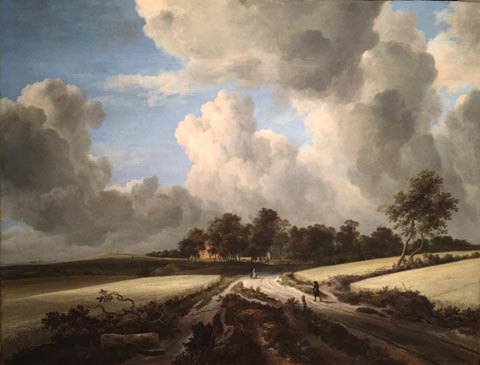
Jacob Van Ruisdael, 1668-1682
Wheat Fields, c 1670 |
The palace is surrounded with a formal French garden, with hedgerows, pavilions, obelisks with paths and manicured gardens. French style gardens like this one are meant to show an idealized and controlled view of nature, both ordered and harmonious.
Jacob Van Ruisdael was considered the pre-eminent landscape painter during the Golden Age and was quite popular. Today, twenty-seven of his views of Dutch fields survive. Wheat Fields is an example of how Jacob Van Ruidsael used the building blocks of land, sky and sea to create his vision of cultivated nature.
On the road, a man is walking with a pack on his back. He is approaching a woman and a child while darkened cumulus clouds dominate the sky. In the distance to the left there is a glimpse of boats at sea, knitting this into a quintessential Dutch landscape as it fits the Netherlands into the context of the wider world.
|
| Portrait paintings (from 1633 to 1665) |
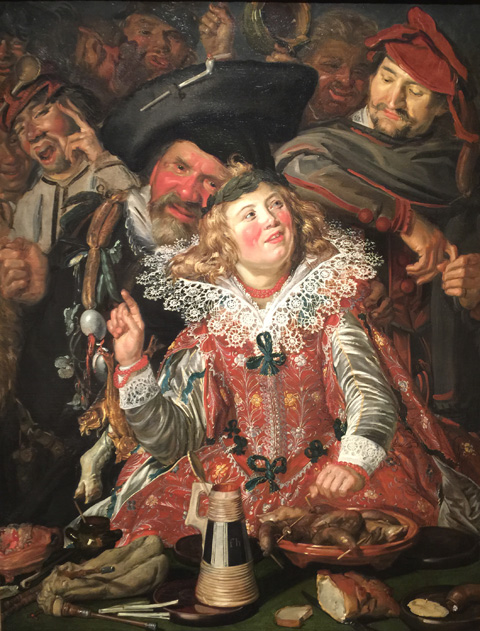
Frans Hals, 1582-1666
Merrymakers at Shrovetide, c 1616-17 |
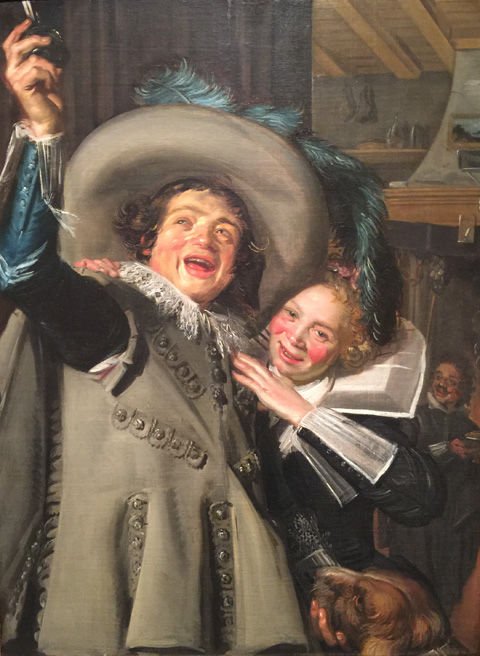
Frans Hals, 1582-1666
Young Man and Woman in an Inn, 1623 |
Frans Hals is known for his lively portraits, with noticeably loose brushwork. Where Rembrandt is known for portraits based on the golden glow of low light, Hals preferred daylight and the silvery sheen it provided. To put it into musical terms, Hals was the treble of portraits while Rembrandt was the bass.
Merrymakers at Shrovetide shows a Dutch Mardi Gras scene. In seventeenth-century Holland, Shrovetide was the occasion for theatrical performances by the painters’ guilds. The exhibition's placard reads, "Here, Hals depicts two stock figures from these plays, Hans Worst, with a sausage dangling from his cap, and Pekelharing, who sports a garland of salted fish and eggs. They flank a richly dressed girl (probably a boy dressed in drag, as women were not permitted to perform on these occasions). Still life elements litter the foreground, evoking both the traditional but festive foods, showing an abundance of erotic innuendo."
Young Man and Woman in an Inn is again painted with bold brushwork and shows an unabashed gentleman and his lady in the doorway of an inn or a brothel. The couple's red cheeks and open mouths shows that they have given into revelry and have left behind rules of comportment.
|
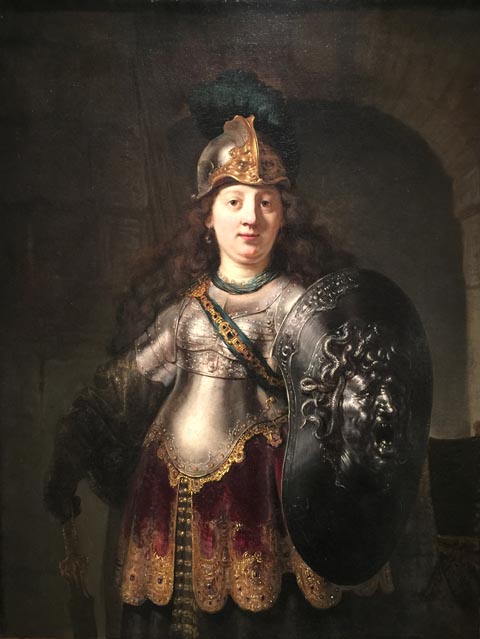
Rembrandt Van Rijn, 1606-1669
Bellona, 1633 |

Rembrandt Van Rijn, 1606-1669
Aristotle with a Bust of Homer, 1653 |
Bellona recalls an ancient myth, Bellona, the Roman goddess of war. When Rembrandt painted this, the Dutch were involved in the Eighty Years War with Spain, and it may have been a statement of Dutch resolve and readiness in the conflict. Rembrandt chooses to depict the ancient goddess as a Dutch warrior. His model, a contemporary Dutch woman, is dressed in armor, and a fearsome glistening shield gives Rembrandt an opportunity to put his painterly skills on display.
Aristotle with a Bust of Homer is one of Rembradt's best known paintings. Aristotle, here pictured as a richly dressed Dutch gentleman, rests his hand on a bust of Homer, the epic poet and philosopher who wrote the Iliad and Odyssey. Aristotle is wearing a golden chain and medallion. On the medallion is a portrait of Aristotle's pupil, Alexander the Great. Rembrandt was commissioned to do this painting by a Sicilian patron.
|
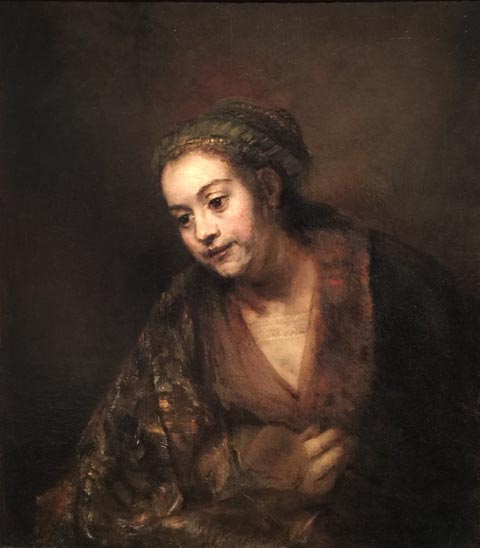
Rembrandt Van Rijn, 1606-1669
Hendrickje Stoffels (1626-1663), mid 1650's |

Rembrandt Van Rijn, 1606-1669
Self Portrait , mid 1660 |
Hendrickje Stoffels came to be Rembrandt's common-law wife and the mother of his daughter Cornelia. She came into Rembrandt's life as his housekeeper and is believed to have served as a model for a number of Rembrandt's paintings. This painting is believed to come from earlier in their relationship. Her gesture of holding one hand against her robe, holding it closed, is a pose Rembrandt used in many paintings and drawings.
Self Portrait, mid 1660 is one of more than forty self portraits done by Rembrandt. In this one, he is 54 years old. Rembrandt is honest in his portrayal, not doctoring the effects of aging. He built up the paint to give high relief to show his furrowed brow, the heavy pouches beneath his eyes and his double chin.
|
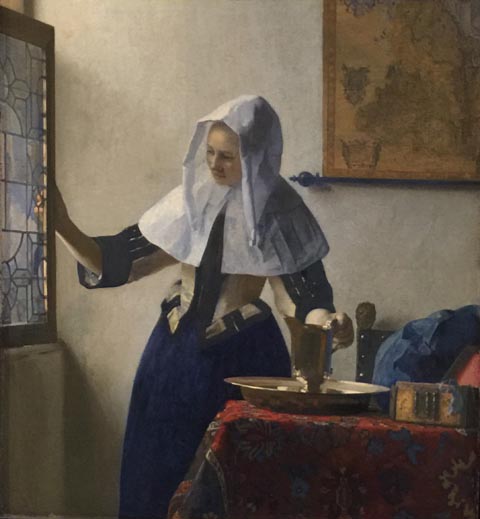
Johannes Vermeer, 1632-1675
Young Woman with a Water Pitcher, c 1662 |

Johannes Vermeer, 1632-1675
Study of a Young Woman , c 1665-67 |
Johannes Vermeer achieved moderate success during his lifetime. He never traveled outside Holland. He specialized in domestic interior scenes working very slowly and deliberately, using expensive materials and pigments. He was a master at using light. He died young, age 43, falling into obscurity after his death for nearly two centuries. In the 19th century, he was rediscovered. Although only 34 of his paintings survive, he is now considered one of the greatest painters of the Dutch Golden Age.
|
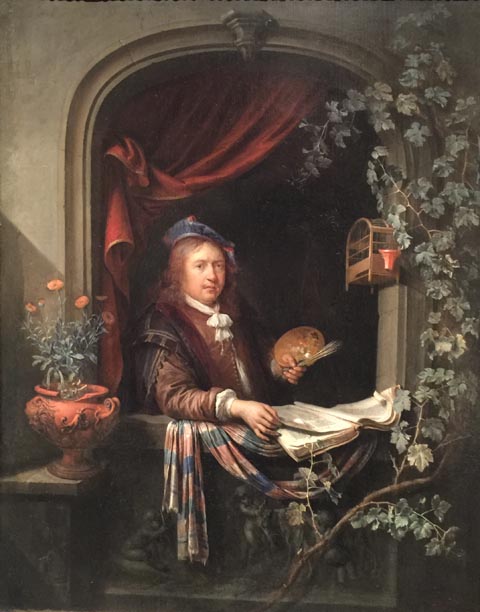
Gerrit Dou, 1613-1675
Self Portrait, c 1665 |
Young Woman with a Water Pitcher shows a woman preparing for the day, using a gilt-silver pitcher and basin. She protects her dress and hair with white linen. Vermeer was a master at interior scenes, and this one is nearly voyeuristic, giving a glimpse into a woman's private moments before presenting herself to the world.
Study of a Young Woman is similar to his painting Girl with the Pearl Earring. Both models for these paintings were dressed in exotic clothing and costume jewelry. This portrait is probably not a commissioned piece of a specific person. Rather it is a "tronie," an interesting and intriguing individual which Vermeer loved to paint in a fanciful costume.
Gerrit Dou was seven years younger than Rembrandt, and was Rembrandt's first pupil. Dou, like his master, was dedicated to self-portraiture. For his self-portraits, Dou often painted himself in fanciful or theatrical costume. In some portraits, he pictured himself as a wealthy aristocrat, but in Self Portrait, 1665, he pictured himself as an artist in an open window with his brushes and palette in hand. He is known for his use of dimly lit rooms, jewel-like surfaces and using painstaking and disciplined methods. Sources say he would spend up to five days just painting one hand, and that his work was so fine, he would manufacture his own brushes.
|
| Still Life paintings (from 1628 to 1716) |
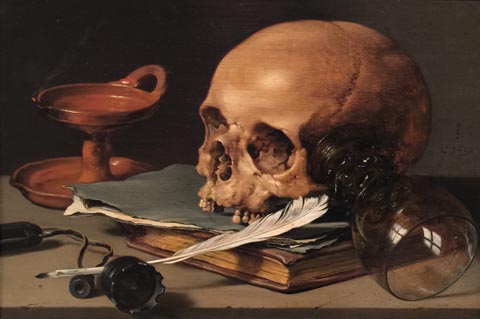
Pieter Claesz, 1596-1660
Still Lilfe with a Skull and Writing Quill, 1628 |

Jan Davidsz De Heem, 1606-1683
Still Life witih a Glass and Oysters, c1640 |
Still life occupied the lowest rung of the hierarchy of painting genres. But as the Dutch gained luxuries of new items previously unknown in Europe, they wanted to celebrate these newfound treasures.
Still life painting grew from smaller more modest compositions in the early 16th century favoring locally available goods to larger and more sumptuous displays of foreign items. The Dutch were masters of detail and as the paintings became more lavish and elaborate, their appeal rose.
|
Still Life with a Skull and Writing Quill by Pieter Claesz makes a deeper philosophical statement. The closed book, the skull missing front teeth, the feather quill resting on tipped-over inkwell and a wine glass on its side all speak to the brevity of life and inescapability of death.
Still Life with a Glass and Oysters by Jan Davidsz De Heem shows a lemon peel curled over a glass with oysters on the half shell with grapes. In 17th century Holland, oysters were believed to possess aphrodisiac qualities.
|
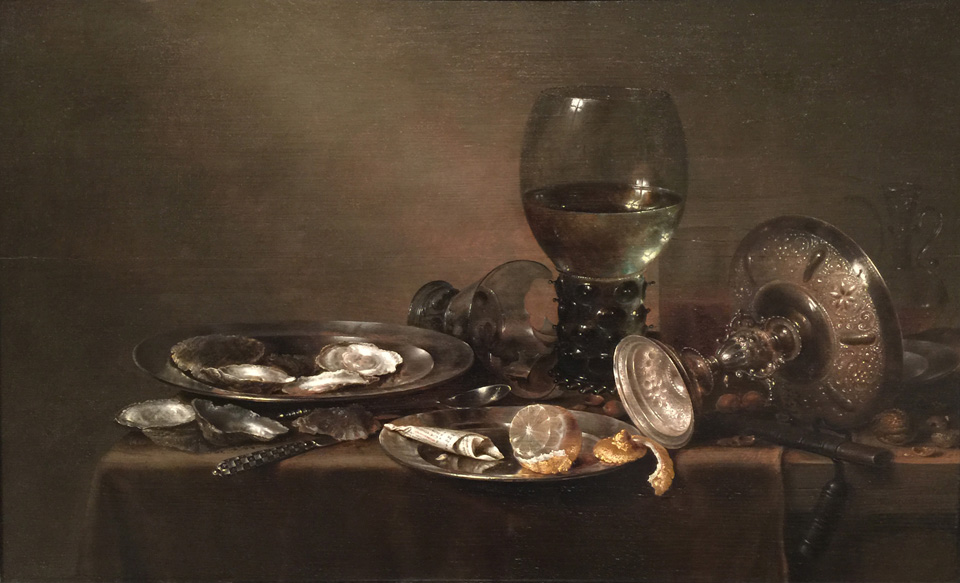
Willem Claesz Hede, 1594-1680
Still Life with Oysters, a Silver Tazza and Glassware, 1635 |
Still Life with Oysters, a Silver Tazza and Glassware by Willem Claesz Heda. Heda is praised for being able to achieve the look of polished silver, glistening oysters and reflections upon a glass while working almost exclusively with shades of gray and brown. At first look, this painting looks like a nice snack, but visual clues lead to a deeper meaning. A paper cone shaped from a torn page from an almanac has been used to apply spices to the oysters. A broken glass and a high standing serving tray on their sides leads the viewer to conclude that this is a feast-like moment that was interrupted. The exhibition placard says this scene is a reminder that our temporary wealth is swiftly passing.
|
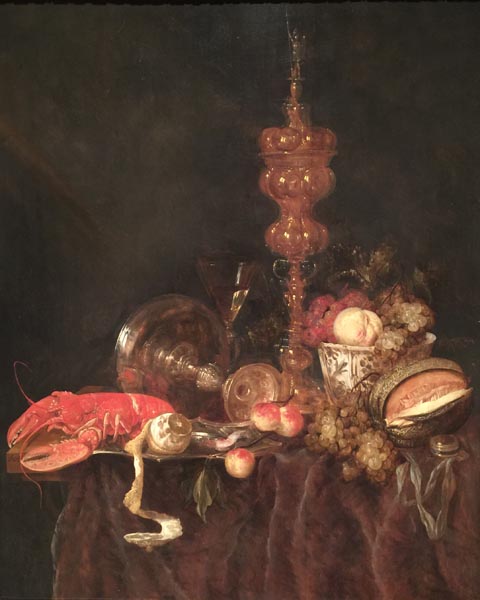
Abraham Van Beyeren, 1620-1690
Still Life with Lobster and Fruit, probably early 1650's |
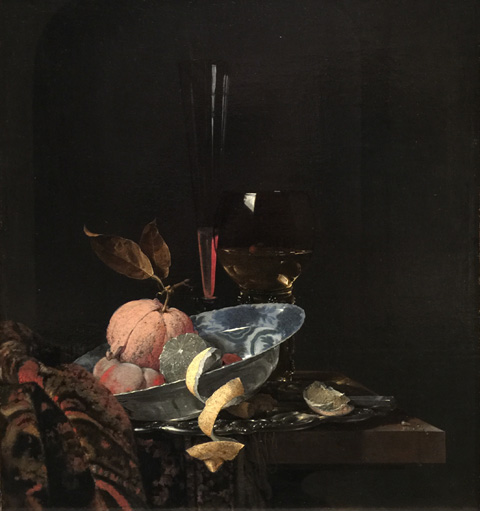
Willem Kalf, 1619-1693
Still Life with Fruit, Glassware and a Wanli Bowl, 1659 |
Still Life with Lobster and Fruit by Abraham Van Beyeren. This abundant feast includes imported luxuries like the blue and white porcelain bowl from China. Dutch wealth and worldly influence raised the confidence of the Dutch people and Dutch still life embraced these new earthly pleasures. As the 17th century drew to a close, still life moved away from reminders of mortality or warnings of the dangers of vanity.
Still Life with Fruit, Glassware and a Wanli Bowl by Willem Kalf shows a Chinese porcelain bowl and a Turkish carpet, both luxurious imports. Kalf fills the bowl with fruits and a lemon peel draped over the side. The bowl is balanced on a slice of bread. Why this arrangement? A contemporary painter and writer said of Kalf, "He surpassed others in still life ... but he never knew how to explain his images, why he depicted this or that, but simply painted whatever took his fancy."
|
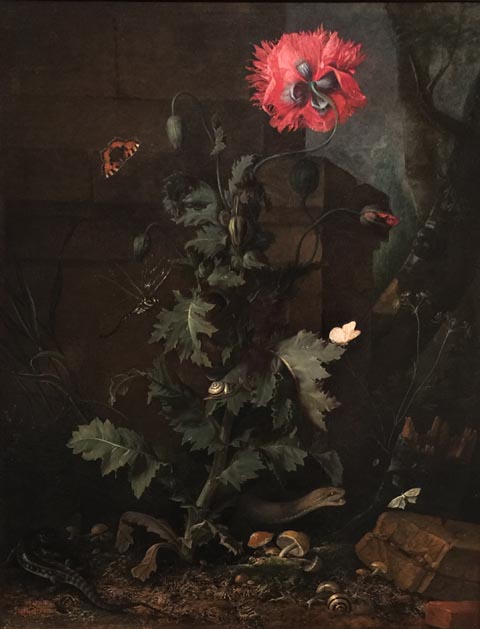
Otto Marseus Van Schrieck, 1619-1678
Still Life with Poppy, Insects and Reptiles, c 1670 |
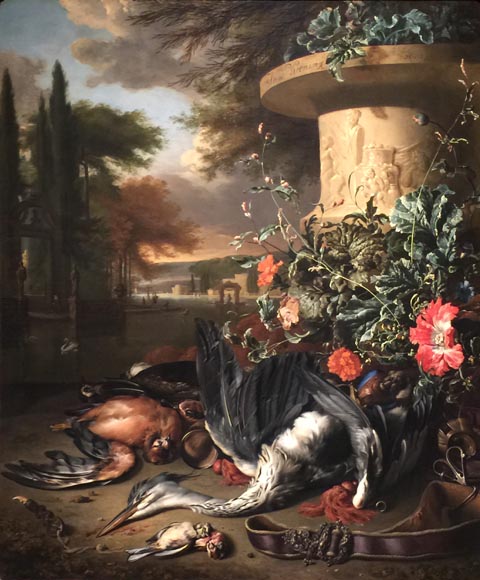
Jan Weenix, 1641 (?) - 1719
Gamepiece with a Dead Heron, 1695 |
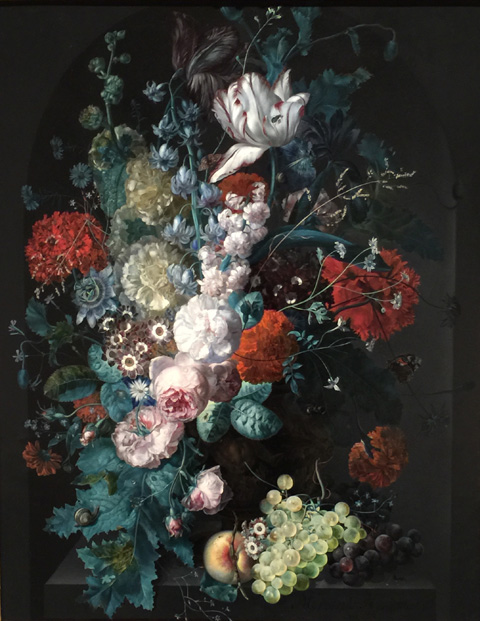
Margareta Haverman, active as a painter 1716 - 1722
A Vase of Flowers, 1716 |
In Still Life with Poppy, Insects and Reptiles, Otto Marseus Van Schrieck shows a plant growing outdoors rather than flowers arranged in a vase. He includes the forest floor with mushrooms, a lizard, snake, snails and butterflies. He was nicknamed "The Stuffler" because he was frequently observed rooting around in undergrowth. He was keenly interested in the science of plants and animals.
Gamepiece with a Dead Heron by Jan Weenix is probably a painting created for a townsperson. It shows the bounty of an excursion, a hunt on a country estate. The neck of a heron is predominately pictured, while other birds spill out of the game bag. These animals are trophies. In the background, aristocratic figures stroll on the edge of an ornamental pond with gliding swans. Dominance of nature was a recurring theme in the mid 17th century.
A Vase of Flowers by Margaretha Haverman was done in 1716, the dawning years of the 18th century. At that time, women painters did not have access to nude models and figurative training, so women artists turned to still life. Only one other of her floral still life exists today, Flower Still Life on a Stone Slab with Butterfly and other Insects at the Statens Museum for Kunst in Copenhagen.
A talented student, she was accepted into the Royal Academy in Paris, but was expelled for reasons lost to history. However, one source says that the school wrongly accused that her acceptance work had been done by Margaretha's former teacher, Jan Van Huysum.
|
| The Metropolitan Museum's exhibition page | Back to the Top |
| Gallery Notes ... |
Bodega Bay artist Linda Sorensen is currently a guest artist at Graton Gallery in Graton, Califormia. The current exhibit ends January 19, 2020, followed by a juried "small works" show there. Showing there are oil paintings of iconic Sonoma County scenery: shorebreak seascapes, vineyards, redwoods and the Russian River, and Spring's blossoming apple trees.
Her large studio, also in Graton, is available to view by appointment, and presents in addition to those favorite subjects the Southwest, Hawaii, Oregon's spectacular mountainscapes, and beloved California natural wonders. Also on view are abstract expressionist and "hybrid" paintings: both new works and selections done in the '60s and '70s.
The large brick studios building, Atelier One on Bowen St., is not a shopping destination but instead working studios, so please make arrangements to meet there and for entry.
lindasorensen@earthlink.net
art@bodegabayheritagegallery.com
707-875-2911 (text and cellphone)
Linda is also represented at Corrick's (Art Trails Gallery) on 4th St. in downtown Santa Rosa.

|
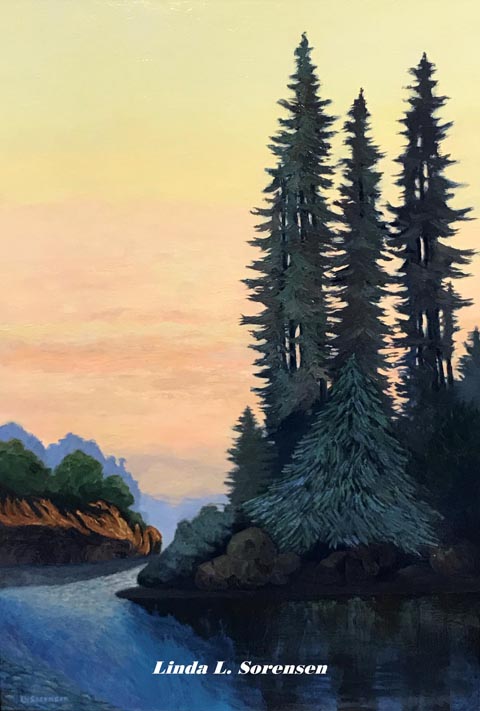
Riversong
36 x 24 |
Left .... Linda Sorensen with Keven Brown at Corrick's, Downtown Santa Rosa. Her two paintings included in the "Autumn's Bounty" special exhibit both sold, but others will be on view. Ask staff to be directed to her area of wall space,
|
| What's showing in Bodega Bay? |
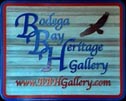 |
Bodega Bay Heritage Gallery
by appointment in Graton or Bodega Bay
http://www.BodegaBayHeritageGallery.com | Call or Text 707-875-2911
email: Art@BodegaBayHeritageGallery.com
|
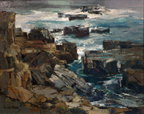
"Composed by Ocean"
Joshua Meador |

Ren Brown |
The Ren Brown Collection
1781 Coast Highway One, Bodega Bay, 94923
707-875-2922 | rbc4art@renbrown.com
http://www.renbrown.com | Back to the Top |
 |
Bodega Bay's Jean Warren Watercolors
Bodega Bay resident Jean Warren says her paintings
are reflections of the places she has lived and traveled.
Jean is a signature member of the National Watercolor Society,
California Watercolor Association and full member of Society of Layerists in Multi-Media.
Visit Jean's site and view examples at the Healdsburg Center for the Arts
http://www.JeanWarren.com
|
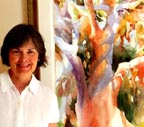
|
What's showing nearby?
in Sonoma, Napa & Marin Counties |
 |
IN SEBASTOPOL, Sebastopol Center for the Arts
home of Sonoma County's Art @ the Source and Art Trails
282 S. High Street, Sebastopol, CA 95472 707.829.4797
Hours: Tue - Fri 10am - 4pm, Sat & Sun 1 - 4pm |

Corrick's Keven Brown |
IN SANTA ROSA
Corrick's Art Trails Gallery | http://www.corricks.com/arttrailsgallery
637 Fourth Street, Santa Rosa, CA 95401 | Contact:: http://www.corricks.com/contact-us
Corrick's has been a Santa Rosa Treasure since 1915,
a downtown stationery store serving the community's "cultural hub."
Corrick's has long supported local artists with its impressive "ART TRAILS GALLERY,"
including paintings by Linda Sorensen.
Corricks offers a number of originals by famed Santa Rosa artist, Maurice Lapp ... (see our August 2017 article)
located on Fourth Street, steps away from Santa Rosa's revitalized town square
and Fourth Street's Russian River Brewery |
 |

Dennis Calabi
|
IN SANTA ROSA Calabi Gallery | http://www.calabigallery.com
We are located at 456 Tenth Street in Santa Rosa.
Contact us with any questions at (707) 781-7070 or info@calabigallery.com
456 Tenth Street, Santa Rosa, CA 95401 | email: info@calabigallery.com | 707-781-7070
Famed master conservator Dennis Calabi brings his rare knowledge and experience
to present a tasteful and eclectic array of primarily 20th century artwork.
http://www.calabigallery.com | Back to the Top
|

Easton, Crustacean Dancing Dream, American Alabaster |
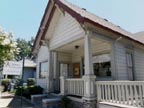 |
IN Santa Rosa The Annex Galleries
specializing in 19th, 20th, and 21st century American and European fine prints
The Annex Galleries is a member of the International Fine Print Dealers Association (IFPDA).
http://www.AnnexGalleries.com | Back to the Top |
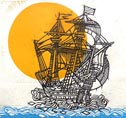 |
IN GRATON Graton Gallery
home of many of Sonoma County's best artists
http://www.gratongallery.com
Sally Baker, Marylu Downing, Tim Hayworth, Bruce K. Hopkins, Rik Olson, Susan Proehl, Sandra Rubin, Mylette Welch
Graton Gallery | (707) 829-8912 | artshow@gratongallery.com
9048 Graton Road, Graton CA 95444 | Open Wednesday ~ Saturday 10:30 to 6, Sunday 10:30 to 4 |
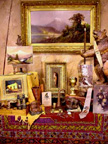 |
IN DUNCANS MILLS Christopher Queen Galleries
3 miles east of Hwy 1 on Hwy 116 on the Russian River
http://www.christopherqueengallery.com |707-865-1318| Back to the Top |
 |
IN Healdsburg Paul Mahder Gallery
http://www.paulmahdergallery.com
(707) 473-9150 | Info@paulmahdergallery.com
222 Mill Healdsburg Avenue, Healdsburg, CA 95448 | Open Weds - Mon, 10-6, Sundays, 10-5 |
 |
IN Healdsburg Hammerfriar Gallery
http://www.hammerfriar.com
(707) 473-9600
132 Mill Street, Healdsburg, CA 95448 | Open Tues - Fri 10 to 6, Sat 10 - 5, Sun 12 - 4
|
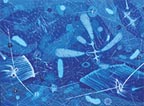 |
 |
IN PETALUMA Petaluma Arts Center
"... to celebrate local artists and their contributions and involve the whole community"
|
 |
| Links to current museum exhibits relevant to Early California Art |
| The Greater Bay Area |
The Walt Disney Family Museum
This museum tells Walt's story from the early days.
(on the Parade Grounds) 104 Montgomery Street,
The Presidio of San Francisco, CA 94129
-- view location on Google Maps --
|
 |
San Francisco
de Young Museum
Permanent Collection
|
 |
San Francisco
California Historical Society
|
 |
San Francisco
Legion of Honor
James Tissot: Fashion and Faith
through Feb 9
-Permanent European and Impressionist Paintings
|
 |
San Francisco
Contemporary Jewish Museum
|
 |
Oakland
Oakland Museum of California
-- ongoing Gallery of California Art
-showcasing over 800 works
from the OMCA's collection
|
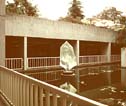 |
San Francisco
SFMOMA
Wayne Thiebaud: Paintings and Drawings
through March 10, 2019
http://www.sfmoma.org |
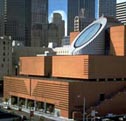 |
Santa Rosa
The Museums of Sonoma County |
 |
Santa Rosa
Charles M. Schultz Museum
|
 |
Moraga
St Mary's College Museum of Art
Hearst Art Gallery
|
 |
Sonoma
Mission San Francisco de Solano Museum
featuring the famed watercolor paintings
of the California Missions
by Christian Jorgensen |
 |
Sonoma
Sonoma Valley Museum of Art
551 Broadway, Sonoma CA
(707) 939-7862 |
 |
Ukiah
Grace Hudson Museum
http://www.gracehudsonmuseum.org |
 |
Bolinas
Bolinas Museum
featuring their permanent collection,
including Ludmilla and Thadeus Welch,
Arthur William Best, Jack Wisby,
Russell Chatham, Alfred Farnsworth. |
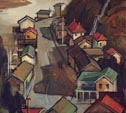 |
Walnut Creek
The Bedford Gallery, Lesher
Center for the Arts |
 |
San Jose
San Jose Museum of Art
approximately 2,000 20th & 21st
century artworks including paintings, sculpture,
new media, photography, drawings, prints, and artist books. |
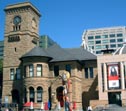 |
Monterey
Monterey Museum of Art
Ongoing exhibitions ...
Museums Permanent Collection
including William Ritschel, Armin Hansen
and E. Charlton Fortune
http://www.montereyart.org
|
 |
Palo Alto
Cantor Art Center at Stanford University |
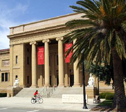 |
Monterey
Salvador Dali Museum
|
 |
Sacramento
Crocker Art Museum
NEW TWO-YEAR LONG EXHIBIT
COMING ... Jan 26 - May 17
Granville Redmond, The Eloquent Palette
& their marvelous Permanent Collection |
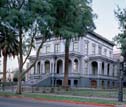 |
Sacramento
Capitol Museum
Governor's Portrait Gallery
Permanent Exhibits
(including one of our galllery's favorite artists,
Robert Rishell's portrait of Gov. Ronald Reagan |
 |
Stockton's Treasure!
The Haggin Museum
-Largest exhibition of Albert Beirstadt paintings anywhere,
plus the works of Joseph Christian Leyendecker,
Norman Rockwell's mentor.
see our Newsletter article, April 2011 |
 |
| Southern California (and Arizona) |
Los Angeles
Los Angeles Museum of Art
Art of the Americas, Level 3:
Artworks of paintings and sculptures
from the colonial period to World War II—
a survey of of art and culture
& "Levitated Mass" |
 |
Irvine (now part of UC-Irvine)
The Irvine Museum
El Camino del Oro, Sept 14 - Jan 11
Paintings of the California Missions era
by many of California's noted artists
|
 |
Santa Barbara
The Santa Barbara Museum of Art |
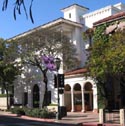 |
Orange
LA Area Scene Paintings from the Hilbert Collection,
A Fine Romance: Images of Love
in Classic American Illistration
through - April 18, 2020
Hilbert Museum, Chapman University
|
 |
Pasaden
Norton Simon Museum
-an Impressive Permanent collection,
European impressionist and post impressionist paintings
See our newsletter from March 2014 |
 |
San Marino (near Pasadena)
The Huntington Library
American Art Collection
Paintings by John Singer Sargent,
Edward Hopper, Robert Henri,
Albert Bierstadt, Thomas Moran,
William Keith, Mary Cassatt,
Thomas Hart Benton and many more.
|
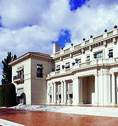 |
San Diego
San Diego Museum of Art
Permanent Collection |
 |
Palm Springs
Palm Springs Art Museum
Permanent Collection
American 19th century Landscape Painting |
 |
Phoenix, AZ
Phoenix Art Museum
an excellent sampling of
Artists of the American West |
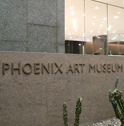 |
Los Angeles
California African American Art Museum
adjacent to the LA Coliseum
(see our newsletter articleof their
Ernie Barne's Exhibition September 2019)
|
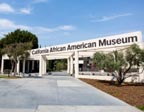 |
| & Beyond |
Honolulu, HI
Honolulu Museum
(see our Newsletter article
from February, 2015)
|
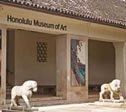 |
Kamuela, HI (Big Island)
Issacs Art Center
65-1268 Kawaihae Road
Kamuela, HI 96743
(See our Dec '16 article "Hawaii's Paul Gauguin,"
modernist Madge Tennent, 1889-1972)
|
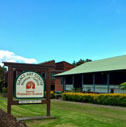 |
Seattle, WA
Seattle Art Museum
( see our article Mar 2018
French and American Paintings ) |
 |
Portland, OR
Portland Art Museum
Permanent Collection: American Art |
 |
Washington D.C.
The Renwick Gallery
Permanent ... Grand Salon Paintings
from the Smithsonian American Art Museum |
 |
Chicago, IL
Art Institute of Chicago
Permanent collection:
the Impressionists |
 |
Cedar Rapids, IA
The Cedar Rapids Museum of Art
Grant Wood: In Focus
is an ongoing permanent collection exhibition. |
 |
Bentonville, AR
Crystal Bridges
Museum of American Art
|
 |
Washington D.C.
The National Gallery
Permanent collection
American Paintings |
 |
Philadelphia , PA
The Philadelphia Museum of Art |
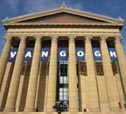 |
Philadelphia , PA
Barnes Foundation, Philadelphia Campus |
 |
Brooklyn, NY
The Brooklyn Museum
American Art
Permanent Collection |
 |
New York , NY
The Whitney Museum of American Art
The largest selection of works by Edward Hopper |
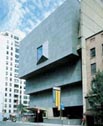 |
New York , NY
Metropolitan Museum of Art
Its extensive collection of American Art |
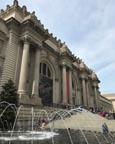 |
Detroit, MI
Detroit Institute of Arts
American Art
Permanent Collection |
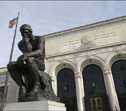 |
Ottawa, Ontario
National Gallery of Canada |
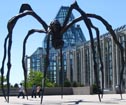 |
Denver, CO
Denver Art Museum
Monet, the Truth of Nature
through Feb 2 |
 |
|
|
